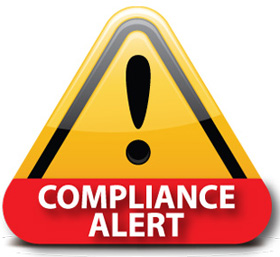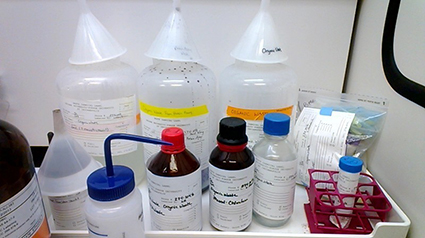Chemical Waste Compliance Update
 “You may delay, but time will not.”
~ Benjamin Franklin “You may delay, but time will not.”
~ Benjamin Franklin
June 18, 2015 will mark two years since the campus last underwent a comprehensive chemical/hazardous waste compliance inspection. This inspection is most commonly completed by the Indiana Department of Environmental Management (IDEM). Occasionally the U.S. Environmental Protection Agency may conduct the inspection in place of IDEM - which was the case in 2009.
The goal of IDEM is to ensure that facilities such as IUPUI which generate large volumes of regulated hazardous wastes are inspected once every two years. This spring will start the window of opportunity for when the campus should expect the next compliance inspection.
Previous inspection reports and annual chemical waste reports are typically reviewed by the agency prior to the inspection. Laboratories which were inspected in 2013 and were found to have chemical waste management deficiencies should fully expect to be included in this next compliance inspection.
In preparation for the inspection, the Office of Environmental Health and Safety will resume monthly compliance tours of laboratories located in the Engineering Science and Technology (SL), the Science (LD) and the Science and Engineering Laboratory (EL) Buildings.
In particular, EHS staff will check to ensure that laboratories are managing their chemical wastes in a manner which is compliant with state and federal regulations. Following are four simple compliance steps to ensure your lab continually maintains compliance:
-
Know what chemical wastes your lab produces and where they are currently located.
- Ensure that all waste chemical containers are labeled prior to adding any chemical waste to the container. Ensure the label includes both the name of the chemical waste and all constituents.
- Ensure that your chemical waste containers are closed when not actively being filled.
- Refer your chemical waste to EHS for final disposal as soon as the container is full. (http://ehs.iupui.edu/waste-manifest.asp)
The following picture taken in 2013 in SL 209 and very clearly illustrates the proper in-lab management of chemical wastes:

Please note in the photograph above that:
- A specific area has been designated in the fume hood for the lab’s chemical wastes – as defined by the plastic tray. The lab staff knows exactly what chemical wastes are currently being generated in the lab and where the wastes are to be found.
- Each container of chemical waste has been appropriately labeled – complete with the name of the chemical waste and a complete listing of constituents.
- Each container is closed when not actively being filled – including the plastic bag of pipette tips as noted in the upper right hand corner. While several of the dump jugs have dedicated funnels, the lids have been placed back on the container and the funnels simply set on top for future use.
Please contact EHS at 274-2005 for additional information or with any chemical waste handling/disposal questions.
|